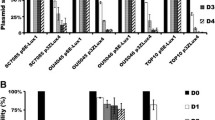Abstract
Mice intragastrically infected with Listeria monocytogenes EGDe and Staphylococcus aureus Xen 36 showed no visible signs of infection over 48 h. However, high numbers (6.2 × 105 cfu/mg feces) of S. aureus Xen 36 were detected 4 h, and 3.3 × 105 cfu/mg feces of L. monocytogenes EGDe 8 h, after administration. Mice intraperitoneally infected with S. aureus Xen 36 (1 × 107 cfu) developed infection immediately after administration and for at least the following 48 h. Injection with higher cell numbers of S. aureus Xen 36 (2 × 108 cfu) resulted in more intense bioluminescence (infection) of the peritoneal cavity. Injection of S. aureus Xen 36 in the tail and penile veins resulted in localized tissue infection for the first 120 h. Injection of S. aureus Xen 36 into the thigh produced a faint bioluminescent signal for 15 min. Nisin F injected into the peritoneal cavity at the same area of infection led to an immediate statistically significant decrease in infection (from 2 × 106 p/s/cm2/sr to 3 × 105 p/s/cm2/sr) within 2 h. Similar results were recorded when nisin F was injected subcutaneously. Intraperitoneal administration is an optimal administration route for bacterial infection and treatment with antimicrobial peptides.





Similar content being viewed by others
References
Arioli V, Rossi E (1970) Errors related to different techniques of intraperitoneal injection in mice. Appl Microbiol 19:704–705
Brand AM, De Kwaadsteniet M, Dicks LMT (2010) The ability of Nisin F to control Staphylococcus aureus infection in the peritoneal cavity, as studied in mice. Lett Appl Microbiol 51:645–649
Bron PA, Monk IR, Corr SC, Hill C, Gahan CGM (2006) Novel luciferace reporter system for in vitro and organ-specific monitoring of differential gene expression in Listeria monocytogenes. Appl Environ Microbiol 72:2876–2884
Contag CH, Contag PR, Mullins JI, Spilman S, Stevenson DK, Benaron DA (1995) Photonic detection of bacterial pathogens in living hosts. Mol Microbiol 18:593–603
Das RG, North D (2007) Implications of experimental technique for analysis and interpretation of data from animal experiments: outliers and increased variability resulting from failure of intraperitoneal injection procedures. Lab Anim 41:312–320
De Kwaadsteniet M, Ten Doeschate K, Dicks LMT (2008) Characterization of the structural gene encoding nisin F, a new lantibiotic produced by a Lactococcus lactis subsp. lactis isolate from freshwater fish (Clarius gariepinus). Appl Environ Microbiol 74:547–549
De Kwaadsteniet M, Van Reenen CA, Dicks LMT (2010) Evaluation of nisin F in the treatment of subcutaneous skin infections, as monitored by using a bioluminescent strain of Staphylococcus aureus. Probiotics Antimicrob Proteins 2:61–65
Francis KP, Joh D, Bellinger-Kawahara C, Hawkinson MJ, Purchio TF, Contag PR (2000) Monitoring bioluminescent Staphylococcus aureus infections in living mice using a novel luxABCDE construct. Infect Immun 68:3594–3600
Gould DJ, Chamberlain A (1995) Staphylococcus aureus: a review of the literature. J Clin Nurs 4:5–12
Guggenheim M, Zbinden R, Handschin A, Gohritz A, Altintas MA, Giovanoli P (2009) Changes in bacterial isolates from burn wounds and their antibiograms: A 20-year study (1986–2005). Burns 35:553–560
Hackbarth CJ, Chambers HF (1989) Methicillin-resistant staphylococci: genetics and mechanisms of resistance. Antimicrob Agents Chemother 33:991–994
Kim JY (2009) Understanding the evolution of methicillin-resistant Staphylococcus aureus. Clin Microbiol Newsl 31:17–23
Lowy FD (1998) Staphylococcus aureus infections. N Engl J Med 339:520–532
Maree CL, Daum RS, Boyle-Vavra S, Matayoshi K, Miller LG (2007) Community-associated methicillin-resistant Staphylococcus aureus isolates causing healthcare-associated infections. Emerg Infect Dis 13:236–242
Miner NA, Koehler J, Greenaway L (1969) Intraperitoneal injection of mice. Appl Microbiol 17:250–251
Otter JA, French GL (2006) Nosocomial transmission of community-associated methicillin-resistant Staphylococcus aureus: an emerging threat. Lancet Infect Dis 6:753–755
Oussoren C, Velinova M, Scherphof G, Van der Want JJ, Van Rooijen N, Storm G (1998) Lymphatic uptake and biodistribution of liposomes after subcutaneous injection: IV. Fate of liposomes in regional lymph nodes. Biochim Biophys Acta 1370:259–272
Sambrook JE, Fritsch F, Maniatis J (1989) Molecular cloning: a laboratory manual, 2nd edn. Cold Spring Harbor Laboratory Press, Cold Spring Harbor
Steward JP, Ornellas EP, Beernink KD, Northway WH (1968) Errors in the technique of intraperitoneal injection of mice. Appl Microbiol 16:1418–1419
Stranger-Jones YK, Bae T, Schneewind O (2006) Vaccine assembly from surface proteins of Staphylococcus aureus. PNAS USA 103:16942–16947
Taylor GD, Kibsey P, Kirkland T, Burroughs E, Tredget E (1992) Predominance of staphylococcal organisms in infections occurring in a burns intensive care unit. Burns 18:332–335
Van Reenen CA, Dicks LMT, Chikindas ML (1998) Isolation, purification and partial characterization of plantaricin 423, a bacteriocin produced by Lactobacillus plantarum. J Appl Microbiol 84:1131–1137
Watson D, Sleator RD, Casey PG, Hill C, Gahan CG (2009) Specific osmolyte transporters mediate bile tolerance in Listeria monocytogenes. Infect Immun 77:4895–4904
Acknowledgments
The authors thank the National Research Foundation (NRF), South Africa, for funding.
Author information
Authors and Affiliations
Corresponding author
Rights and permissions
About this article
Cite this article
Brand, A.M., Smith, R., de Kwaadsteniet, M. et al. Development of a Murine Model with Optimal Routes for Bacterial Infection and Treatment, as Determined with Bioluminescent Imaging in C57BL/6 Mice. Probiotics & Antimicro. Prot. 3, 125–131 (2011). https://doi.org/10.1007/s12602-011-9069-4
Published:
Issue Date:
DOI: https://doi.org/10.1007/s12602-011-9069-4




